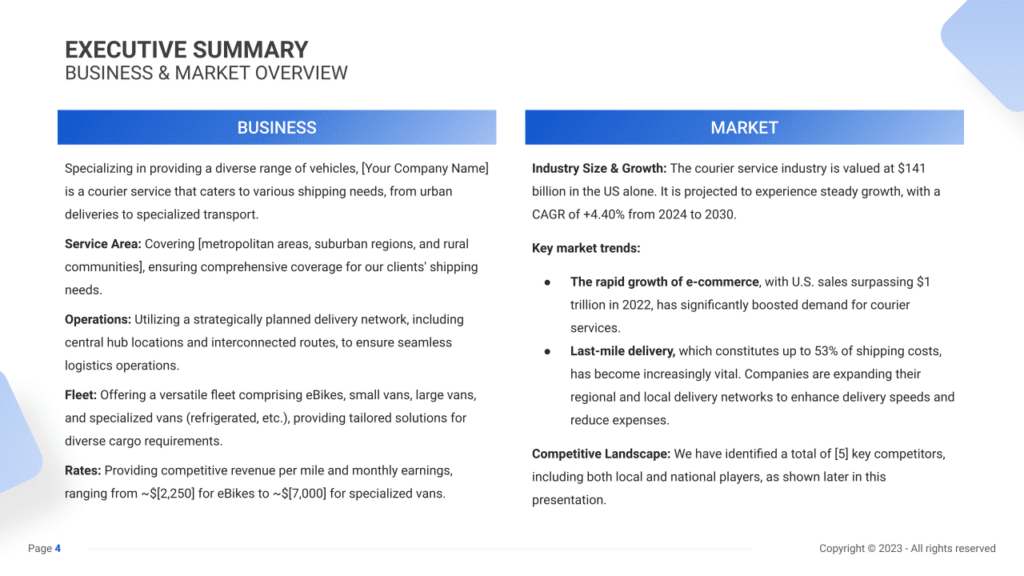
Creating a comprehensive business plan is crucial for launching and running a successful courier business. This plan serves as your roadmap, detailing your vision, operational strategies, and financial plan. It helps establish your courier business’s identity, navigate the competitive market, and secure funding for growth.
This article not only breaks down the critical components of a courier business plan, but also provides an example of a business plan to help you craft your own.
Whether you’re an experienced entrepreneur or new to the service industry, this guide, complete with a business plan example, lays the groundwork for turning your courier business concept into reality. Let’s dive in!
Our courier business plan is meticulously crafted to cover all crucial elements vital for a thorough strategy. It encompasses the company’s operations, marketing tactics, market setting, competitors, management team, and financial outlook.



Fully editable 30+ slides Powerpoint presentation business plan template.
Download an expert-built 30+ slides Powerpoint business plan template

The Executive Summary introduces your courier service’s business plan, offering a concise overview of your company and its services. It should detail your market positioning, the range of delivery and logistics services you offer, its geographical coverage, capacity, and an outline of day-to-day operations.
This section should also explore how your courier service will integrate into the local and perhaps regional market, including the number of direct competitors within the area, identifying who they are, along with your service’s unique selling points that differentiate it from these competitors.
Furthermore, you should include information about the management and co-founding team, detailing their roles and contributions to the courier service’s success. Additionally, a summary of your financial projections, including revenue and profits over the next five years, should be presented here to provide a clear picture of your courier service’s financial plan.


When detailing the business overview in your executive summary, it’s essential to provide clear and succinct information about your courier service. This includes the name of your company, the areas you serve, and a brief description of your operational model.
These details are not just an introduction to your business; they also showcase its unique aspects. Your unique selling proposition (USP) is what distinguishes your courier service from others. It could be your innovative delivery solutions, your commitment to eco-friendly practices, or your ability to provide customizable delivery options. Your USP should be the highlight of your executive summary, capturing the attention of your readers and illustrating the unique value your business brings to the market.
Example:
For example, “Express Deliveries, Inc.” operates within the bustling metropolitan area of New City, offering an array of delivery solutions from standard packages to specialized logistics services. The company’s USP lies in its state-of-the-art tracking system and customizable delivery options, allowing clients to choose delivery times, handle fragile items with care, and ensure eco-friendly transportation methods.
A thorough understanding and presentation of the market size, growth trends, and industry dynamics are crucial for your market analysis. This segment should underscore the courier service industry’s potential, supported by relevant statistics such as market value and growth forecasts. Discussing current trends, like the surge in e-commerce and the demand for faster delivery times, provides insights into the market’s evolving nature and your business’s place within it.
Moreover, the competitive landscape is a vital component. Your executive summary must identify major competitors and delineate how your courier service stands out. Whether it’s through unparalleled customer service, innovative technology, or niche market targeting, this is your chance to highlight how your service is uniquely positioned in a competitive field.
Example:
Consider “Express Deliveries, Inc.” within the $141 billion courier service industry, expected to grow with the increasing e-commerce market, projected to reach new heights in the coming years. Despite the presence of major players and local competitors, Express Deliveries sets itself apart with its advanced technology, offering real-time tracking and flexible delivery options, catering to the modern consumer’s need for speed and reliability.
The background and expertise of your management team are invaluable assets to your courier business. In your executive summary, emphasize the key qualifications and experiences of your team members, which underpin your business’s potential for success.
This might include the founder’s extensive background in logistics and supply chain management or the operations manager’s innovative approach to route optimization. Showcasing the team’s expertise not only enhances credibility but also reassures potential investors and partners of your courier service’s capacity for success.
Example:
At “Express Deliveries, Inc.,” the team is led by founder and CEO Alex Rivera, who brings over 20 years of experience in logistics and technology integration. The operations are managed by Sam Lee, known for developing efficient routing algorithms that significantly reduce delivery times and costs, adding considerable value to the company’s operational effectiveness and customer satisfaction.
Your financial plan should concisely outline your financial objectives and projections, including anticipated revenue streams and profit margins. This gives a clear overview of your business’s financial health and growth prospects.
Example:
“Express Deliveries, Inc.” aims to achieve $3 million in annual revenue by its third year, with a projected EBITDA margin of 15%. The financial strategy includes investing in advanced logistics software and expanding the fleet with eco-friendly vehicles. Sales growth is anticipated through strategic partnerships, expanding service offerings, and capitalizing on the growing e-commerce market, positioning the company for sustainable profitability and market leadership.
For a courier service, the Business Overview section can be effectively divided into 2 main sections:
Briefly describe the geographical coverage of your courier service, emphasizing the efficiency, reliability, and speed of your operations. Mention the service areas, highlighting its extensive reach including urban, suburban, and if applicable, rural areas.
Explain why this coverage is advantageous in meeting the logistics needs of your target clientele, such as businesses requiring timely deliveries, e-commerce platforms, and individuals in need of quick parcel services.
Detail the range of delivery services offered, from standard parcel delivery to specialized logistics solutions like same-day delivery, temperature-controlled transport, or oversized packages.
Outline your pricing strategy, ensuring it reflects the value and efficiency of the services provided and is competitive within the market you’re targeting. Highlight any flexible pricing plans, bulk delivery discounts, or loyalty programs that provide added value to your clients, encouraging repeat business and customer loyalty.




Fully editable 30+ slides Powerpoint presentation business plan template.
Download an expert-built 30+ slides Powerpoint business plan template


In the Market Overview of your courier service business plan, start by examining the size of the courier and delivery services industry and its growth potential. This analysis is crucial for understanding the market’s scope and identifying expansion opportunities, especially in the context of the booming e-commerce sector and the increasing demand for fast, reliable delivery services.
Proceed to discuss recent market trends, such as the growing consumer and business reliance on e-commerce platforms, the increasing demand for same-day and next-day delivery services, and the integration of advanced technology for tracking and efficiency.
For example, highlight the demand for flexible delivery options, the importance of eco-friendly transportation solutions, and the adoption of digital platforms for seamless order placement and tracking.
A competitive analysis is not just a tool for gauging the position of your courier service in the market and its key competitors; it’s also a fundamental component of your business plan. This analysis helps in identifying your courier service’s unique selling points, essential for differentiating your business in a competitive market.
In addition, the competitive analysis is integral in laying a solid foundation for your business plan. By examining various operational aspects of your competitors, you gain valuable information that ensures your business plan is robust, informed, and tailored to succeed in the current market environment. Let’s dive in!
To begin, it’s crucial to identify and map out competitors in the local courier service market. Analyze both direct competitors, such as other courier companies offering similar services, and indirect competitors like local delivery apps or large logistics companies that may impact the market. Utilize online tools, including maps and review platforms, to gain a geographical understanding of competitor distribution and customer sentiments.
Examine customer reviews on platforms like Google Reviews and Yelp to discern your competitors’ strengths. If a courier service named “Swift Deliveries” consistently receives praise for timely deliveries and reliable tracking, this becomes a significant competitive advantage.

Understanding the strategies employed by competitors involves a comprehensive analysis of various aspects:
Determine your courier service’s unique value proposition to stand out in the market. This could be based on:
Identify gaps in the market through customer feedback and industry trends. For instance, if there is an increasing demand for eco-friendly courier options and competitors are not addressing this, it presents an opportunity for your courier service to differentiate itself.
Consider your service area and target audience. A courier service operating in a bustling urban center might emphasize quick and on-demand services, while one serving suburban areas may focus on reliability and personalized customer interactions.

First, conduct a SWOT analysis for the courier service, highlighting Strengths (such as a diverse fleet that can handle a variety of delivery needs, advanced tracking systems, and reliable customer service), Weaknesses (including potential logistical challenges, dependency on fuel prices, or strong competition), Opportunities (for example, the expanding e-commerce market, potential for technological innovations, and partnerships with local businesses), and Threats (such as regulatory changes, environmental concerns impacting operations, or economic fluctuations that may affect shipping volumes).

Next, develop a marketing strategy that outlines how to attract and retain customers through efficient service offerings, competitive pricing, strategic partnerships, and a strong online presence.
This could include targeted advertising aimed at businesses and individual consumers, loyalty programs, engaging social media campaigns, and active participation in community events to build brand awareness.
Utilize various marketing channels to promote your courier business, raise awareness, and attract potential clients.
Harness the power of digital platforms to reach a wider audience:
Engage with the local community and potential business clients:
Incentivize potential clients and retain existing ones with appealing offers:

Implementing effective sales strategies can optimize revenue streams and enhance customer satisfaction.
Offer additional services to maximize each delivery opportunity:
Facilitate seamless online transactions and client convenience:
Encourage recurring business and loyalty:
Finally, create a detailed timeline that outlines critical milestones for the courier service’s launch, marketing initiatives, customer base expansion, service diversification, and potential for geographic expansion, ensuring the business progresses with clear direction and purpose.
This timeline should include short-term goals, such as launching a user-friendly website and app, as well as long-term objectives, like expanding into new markets or incorporating eco-friendly vehicles into the fleet.

The Management section focuses on the courier business’s management and their direct roles in daily operations and strategic direction. This part is crucial for understanding who is responsible for making key decisions and driving the courier business toward its financial and operational goals.
For your courier business plan, list the core team members, their specific responsibilities, and how their expertise supports the business.


The Financial Plan section is a comprehensive analysis of your financial projections for revenue, expenses, and profitability. It lays out your courier business’s approach to securing funding, managing cash flow, and achieving breakeven.
This section typically includes detailed forecasts for the first 5 years of operation, highlighting expected revenue, operating costs and capital expenditures.
For your courier business plan, provide a snapshot of your financial statement (profit and loss, balance sheet, cash flow statement), as well as your key assumptions (e.g. number of customers and prices, expenses, etc.).
Make sure to cover here
_ Profit and Loss
_ Cash Flow Statement
_ Balance Sheet
_ Use of Funds






Fully editable 30+ slides Powerpoint presentation business plan template.
Download an expert-built 30+ slides Powerpoint business plan template